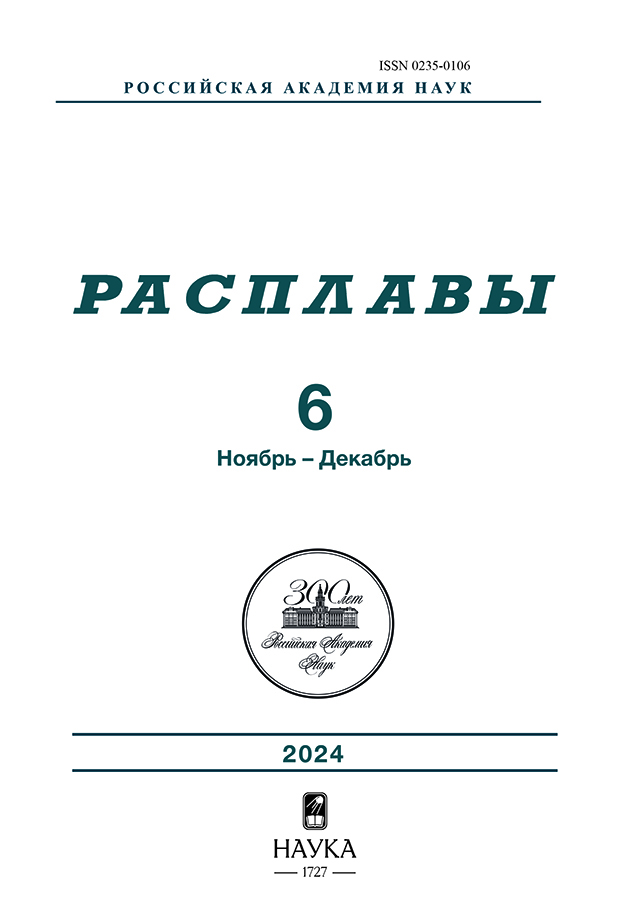Chlorinated graphite as positive electrode for aluminium-ion batteries with 1-ethyl-3-methylimidazolium chloride/aluminium chloride electrolyte
- Autores: Druzhinin K.V.1,2, Kukin A.S.2, Balakin K.Y.1
-
Afiliações:
- Institute of High-Temperature Electrochemistry UB RAS
- Ural Federal University
- Edição: Nº 6 (2024)
- Páginas: 609-623
- Seção: Articles
- URL: https://rjraap.com/0235-0106/article/view/661964
- DOI: https://doi.org/10.31857/S0235010624060037
- ID: 661964
Citar
Texto integral
Resumo
The article defines the dependence type of the cathode polarization of an aluminum-ion battery based on chlorinated graphite of the initial EC-02 type in a low-temperature melt of aluminum chloride with 1-ethyl-3-methylimidazole chloride on the geometric characteristics of the electrode and the current density. It is determined that for the chlorinated graphite material the polarization values are slightly reduced compared to the initial non-chlorinated graphite of the same brand in a similar melt and are 25–50 mV at 1 mA/cm2. The dependence of polarization on the current density does not have a break between the values of 1 and 1.2 mA/cm2, observed for initial graphite, which characterizes the maximum rate of the current-generating reaction, which means an increase in the rate of the main process on the chlorinated graphite. Using a reference experiment on a glassy carbon electrode, the surficial density of chloroaluminate complexes intercalation sites was estimated as about 15%. Accordingly, the maximum degree of intercalation for such materials is 6. Since graphite chlorination does not lead to distortions geometric parameters of its interlayer gaps, the sorption density of chloroaluminate ions is found to increase after chlorination; in the case of non-chlorinated graphite, the degree of intercalation varies with current density from 9 to 18.
Palavras-chave
Texto integral
Sobre autores
K. Druzhinin
Institute of High-Temperature Electrochemistry UB RAS; Ural Federal University
Autor responsável pela correspondência
Email: druzginin@mail.ru
Rússia, Yekaterinburg; Yekaterinburg
A. Kukin
Ural Federal University
Email: druzginin@mail.ru
Rússia, Yekaterinburg
K. Balakin
Institute of High-Temperature Electrochemistry UB RAS
Email: druzginin@mail.ru
Rússia, Yekaterinburg
Bibliografia
- https://projects.leitat.org/horizon-2020-alion-project-kick-off-meeting-leitat-2/ (дата обращения 24.03.2024);
- https://graphenemg.com/graphene-products/graphene-aluminium-ion-battery/ (дата обращения 24.03.2024);
- Brahambhatt R. New aluminum batteries could be the dirt cheap alternative to lithium-ion that we’ve all been waiting for / ZME Science, URL: https://www.zmescience.com/science/news-science/new-aluminum-batteries-could-be-the-dirt-cheap-alternative-to-lithium-ion-that-weve-all-been-waiting-for/ (дата обращения 24.03.2024);
- Li Q., Bjerrum N.J. Aluminum as anode for energy storage and conversion: A review // J. Pow. Sour. 2002. 110. № 1. P. 1-10.
- Kannan G. N., Desikan P. S. A critical appraisal and review of aluminium chloride electrolysis for the production of aluminium // Bul. Electrochem. 1985. 1. № 5. P. 483-488.
- Gifford R., Palmisano B. An aluminum/chlorine rechargeable cell employing a room temperature molten salt electrolyte // J. Electrochem. Soc. 1987. 134. P. 650–654.
- Zafar Z. A., Imtiaz S., Razaq,R., Ji S., Huang T., Zhang Z., Huang Y., Anderson J. A. Cathode materials for rechargeable aluminum batteries: current status and progress // J. Mater. Chem. A. 2017. 5. P. 5646−5660.
- Lin M.-C., Gong M., Lu B., Wu Y., Wang D.-Y., Guan M., Angell M., Chen C., Yang J., Hwang B.-J., Dai H. An ultrafast rechargeable aluminium-ion battery // Nature. 2015. 520. № 7547. P. 324–328.
- Sun H., Wang W., Yu Z., Yuan Y., Wang S., Jiao S. A new aluminium-ion battery with high voltage, high safety and low cost // Royal Soc. Chem. 2015. 65. P. 15-18.
- Wu M., Xu B., Chen L. Q., Ouyang C. Geometry and fast diffusion of AlCl4 cluster intercalated in graphite // El. Acta. 195. P. 158-165.
- Krapchev, T., Ogivil, R., Dresselhaus, M.S. The effect of intercalation on the lattice constants of graphite // Carbon. 1982. 20. № 4. P. 331-337.
- Pham H. D., Horn M., Fernando J. F. S., Patil R., Phadatare M., Golberg D., Olin H., Dubal D.P. Spent graphite from end-of-life Li-ion batteries as a potential electrode for aluminium ion battery // Sus. Mater. Tech. 2020. 26. P. e00230-1-e00230-6.
- Gao Y., Zhu C., Chen Z., Gang L. Understanding ultrafast rechargeable aluminum-ion battery from first-principles // J. Phys. Chem. C. 2017. 121. P. 7131−7138.
- Фиалков А.С. Углерод. Межслоевые соединения и композиты на его основе. М.:Аспект-Пресс, 1997.
- Jung S. C., Kang Y.-J., Yoo D.-J., Choi J. W., Han Y.-K. et.al. Flexible few-layered graphene for the ultrafast rechargeable aluminum-ion battery // J. Phys. Chem. C. 2016. 120. № 25. P. 13384−13389.
- Mohandas K. S., Sanil N., Rodrigues P., Noel M. Electrochemical intercalation of aluminium chloride in graphite in the molten sodium chloroaluminate medium // Carbon. 2003. 41. P. 927–932.
- Crone, W., Wortmann, G., Kaindl, G. Intercalation structure in halogen-intercalated graphite // Synt. Metals. 1989. 28. P. F247-F252.
- Suzuki S., Mazej Z., Zemva B., Ohzawa Y., Nakajima T. Surface passivation of natural graphite electrode for lithium ion battery by chlorine gas // Acta Chim. Slov. 2013. 60. № 3. P. 513-520.
- Larkin P.J. IR and Raman spectroscopy. Principles and spectral interpretation. Elsevier. 2011.
Arquivos suplementares

















